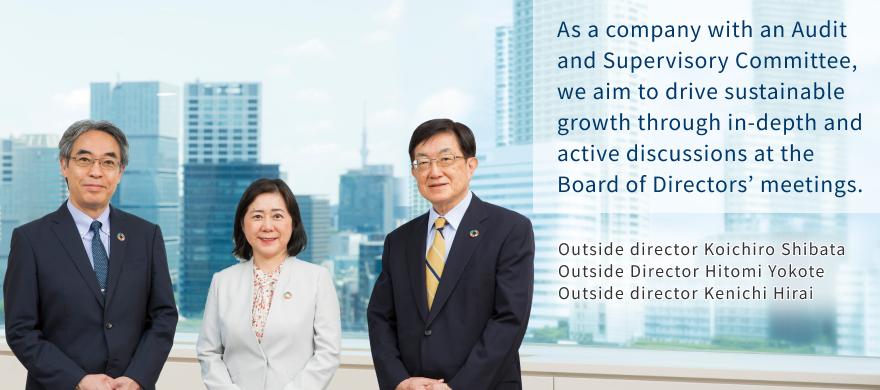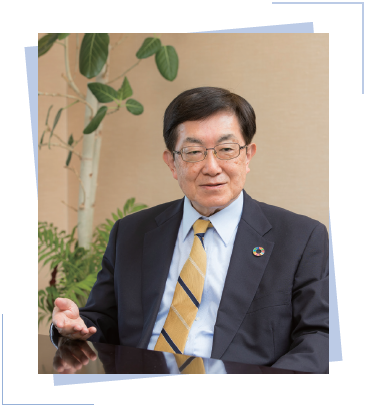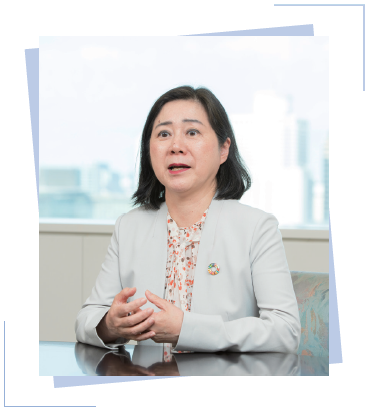Outside Directors Roundtable
At Moriroku Co., Ltd., we are committed to enhancing corporate governance by ensuring transparency and sound management through the appointment of outside directors with diverse backgrounds. In June 2024, we transitioned from a company with a Board of Auditors to one with an Audit and Supervisory Committee structure. Amid this period of significant transformation, we invited three outside directors to openly discuss the current state of the Board of Directors.
Business environment and management challenges
Leveraging Group synergy in a rapidly changing business environment
What are your thoughts on the business environment surrounding Moriroku?
-
Hirai:The biggest topic in the current automotive industry is electrification, which is having an impact on companies across the entire sector. Moriroku’s resin-processed products primarily consist of interior and exterior parts, so at first glance, they may seem to have little connection to the electrification of drivetrains.
However, it is essential to remain alert and continuously assess business opportunities and risks. Additionally, the long-standing reliance on specific customers presents a critical management challenge that will significantly influence future growth and sustainability. Moving forward, it is necessary to step up and engage in new businesses and products.
-
Yokote:As a Group where Resin-Processed Products Business account for 80% of sales, Moriroku is significantly influenced by trends in the automotive industry, including electrification and recent compliance issues. Daily operations must constantly be reevaluated with the latest perspectives, rather than relying on past practices. In this business environment, the Company is facing a challenge with the integration of two distinct business entities
̶Moriroku Technology, an automotive parts manufacturer, and Moriroku Chemicals, a chemical trading company̶set to take place in April 2025. Successfully navigating this transition and ensuring that Moriroku becomes a unified entity will be increasingly important in enhancing the Group’s resilience and competitiveness.
-
Shibata:The biggest challenge, I believe, is how to realize the synergistic effects of two businesses with differing characteristics. From a global perspective, it will be crucial to consistently generate profits while addressing region-specific issues, such as rising labor costs in North America and changes in the Chinese economy. Also, as Ms. Yokote mentioned, ensuring that the norms of “compliance with laws” and ethical standards, which the Company has consistently upheld, are not compromised is a critical responsibility. As outside directors, it is essential to implement stringent checks and establish effective systems with strong deterrence to protect these principles.
Effectiveness of the Board of Directors
The discussions are active, and we seek to deepen them further
Could you provide an overview of the discussions during the Board meetings?
-
Yokote:As the newest outside director, having just been appointed in June 2023, I find the discussions during the Board meetings to be very active. I feel comfortable expressing my opinions, and I believe that President Kurose, along with others, listens carefully and responds appropriately.
-
Shibata:I agree. All outside directors contribute to the discussions, and we sometimes prompt reconsideration of proposals from the executive side in fulfilling our monitoring role. A particularly memorable topic was the active debate on integration into a single entity. As the Company moves forward with this, it is essential to establish a structure that can truly generate synergistic effects. I believe it is important to engage in detailed discussions and continue refining our approach through trial and error.
-
Yokote:In a recent Board meeting, there was a discussion regarding fundraising for our North American subsidiaries. Given the current international situation, various perspectives were presented by outside directors on whether it would be more advantageous to secure funding locally or from the head office, and to what extent the head office should support local management.
As a result of the diverse opinions expressed, the conclusion was deferred to the next meeting.
-
Yokote:As both of you have mentioned, the Board meetings are lively, with many questions and opinions coming from the outside directors. However, there are times when I feel we would benefit from hearing more feedback from the executive side in response to our suggestions. While the Board as a whole is functioning well, as a next step, I believe we should explore ways to better allocate time for discussions and increase the opportunities for two-way communication.
-
Shibata:To ensure that the discussion remains a continuous back-and-forth, it may be helpful to rethink how the agenda is presented. For example, when proposing a topic, if there are differing opinions within the executive side, it might be beneficial to include both viewpoints. This approach could help deepen the discussions.
-
Yokote:Given the numerous agenda items, there are times when individual topics cannot be discussed in depth, so I believe the chair’s management is crucial. We also need to be mindful of the focus and flow of our discussions in response to that.
-
Hirai:One thing I would add is the importance of following up on projects that have been discussed and approved by the Board. While it may be difficult to follow up on everything, for major initiatives, it is important for the Board to periodically check in with the executive side to review progress and results.
Transition to a company with an Audit and Supervisory Committee
Expectations for strengthening the Board’s monitoring function and smoother company operations
Could you tell us about the background and objectives of the transition to a company with an Audit and Supervisory Committee?
-
Hirai:The transition to a company with an Audit and Supervisory Committee had been discussed for some time, but with the larger social trends at play, it was actively advocated by outside directors, including the outside auditors, and this led to its realization. I believe it is the result of constructive discussions aimed at strengthening corporate governance and revitalizing the Board.
-
Shibata:One of the objectives of the change in corporate structure is to strengthen the Board’s monitoring function. Another goal is to delegate a certain level of authority for business execution to the executive side, which will help speed up decision-making. By revising the criteria for matters to be presented to the Board and focusing on more significant topics, I hope the Board will be able concentrate on broader strategic discussions, such as management strategies.
-
Yokote:I share Mr. Shibata ’s expectations regarding the strengthening of the monitoring function and the deepening of discussions at the Board meetings. In addition, with the increase in the number of female directors, I believe we can expect a broader range of perspectives, which will contribute to the revitalization of discussions and the clarification of management challenges.
-
Hirai:To add further, simply changing the structure without substance will not result in effective governance.
So, how can we enhance its effectiveness? Moriroku has a wonderful Management Philosophy and Conduct Guidelines, and it is crucial to instill these principles in every employee and ensure they are practiced by all. First, the management team, including us as outside directors, must reaffirm these principles and internalize them. It is important to engage in discussions with employees, share the management’s thoughts via the intranet, and consistently build upon these efforts through steady, ongoing activities.
The ideal composition of the Board
Enhancing the diversity and expertise of the Board
What are your thoughts on the diversity and skills required for the Board?
-
Hirai:Although the number of female directors has increased, from a diversity perspective, I believe it would also be beneficial to have non-Japanese directors on the Board. Since the Company is a global enterprise with a presence in many countries, especially in North America and China, I would like to see efforts made toward developing talent to the point where local members can be appointed as directors, rather than just outside directors. It may take time, but I believe it is an important goal.
-
Yokote:Executives are being developed in each region, and we have already seen the emergence of foreign nationals as presidents of local subsidiaries. To further promote the development of local executives, it would be beneficial to increase exchanges in human resources, as well as implement initiatives that encourage the respect for diversity and bilingualism. These efforts could help facilitate the emergence of non-Japanese directors.
-
Hirai:Another point is that I believe it is necessary to increase the number of individuals with a deep understanding and awareness of business and the capital markets among the current Board members. By adding a macro perspective and sensitivity to the capital markets, the Board will be able to engage in even deeper discussions.
-
Shibata:The current Board members each come from different backgrounds and bring a diverse range of expertise. Looking ahead it would be constructive to increase the number of outside executives with experience in both technical fields and management. It would also be valuable to hear specialized opinions from a technical perspective as Moriroku strives to enhance its manufacturing capabilities, which are key to the Company’s growth.
Commitment to sustainability management
Incorporating sustainability metrics into the performance-based compensation system for directors
What discussions took place regarding the integration of sustainability metrics into the performance-based compensation system?
-
Shibata:Previously, the restricted stock compensation for directors was linked solely to financial indicators. However, in 2022, with the start of the 13th Mid-term Management Plan, we introduced two sustainability metrics: “GHG emission reduction rate” related to environmental impact, and“ Improved employee engagement” related to workforce satisfaction, with specific numerical targets for each. The inclusion of these metrics in the performancebased compensation system was a topic of extensive discussion at the time within the Nomination & Remuneration Advisory Committee. We have been tracking progress annually, and we expect to see the first results by March 2025, when the final year of the plan concludes.
-
Hirai:The initiative to integrate sustainability metrics into the performance-based compensation for directors was led by the Nomination and Compensation Committee. Incorporating“ employee engagement” aligns with the Company’s core value of respecting people, which reflects the unique culture of Moriroku. It could be a good opportunity for the Company to further promote both internally and externally that it is genuinely committed to enhancing employee satisfaction.
Management executive development plan
The importance of developing management executives with an eye on the next generation and beyond
What kind of discussions are taking place regarding the succession plan for the future?
-
Hirai:For the recent CEO transition, the Nomination & Remuneration Advisory Committee developed a succession plan after conducting interviews with potential candidates. While the transition has just taken place, it is important for the committee to begin preparations for the next CEO transition. It is crucial to focus not only on the CEO role but also on developing systems and concrete training plans to ensure that potential successors are identified and nurtured at both the senior executive level and the levels below. We hope to finalize and implement these plans within this fiscal year.
-
Shibata:It is important to look ahead not just two or three years, but also 10 years or more, to ensure that we are preparing for the next generation of leaders. In addition, we need to ensure that we have potential successors who can step in immediately in the event of an unforeseen situation affecting the top leadership. These are the key points being discussed by the Nomination & Remuneration Advisory Committee. For example, we plan to conduct annual interviews with executiveofficers to understand their activities and plans, which will help guide the development of potential successors. Furthermore, in Moriroku’s case, since the leaders will be required to oversee both a manufacturing company and a trading company, it will be crucial to implement planned and early-stage development, including personnel exchanges.
-
Yokote:Looking ahead, I believe it is important to foster a broad talent pool, create an environment that enhances motivation, and encourage challenges from an early stage. Additionally, while there are already three female executive officers at Moriroku, in order to reflect diverse perspectives in management and drive sustainable growth, I hope to continue promoting diversity through top-down efforts.
Toward sustainable growth
“One Moriroku” for future sustainable growth
Could you share your expectations for the future sustainable growth of the Company?
-
Yokote:To generate significant synergies between the two businesses, creativity, a spirit of challenge, and the ability to read market trends will be required not only from the management team but also from every employee across the Company. In particular, overcoming boundaries to create new business opportunities will be essential.
Effectively leveraging the assets the Company holds overseas will also be crucial. If Moriroku can increase the
number of individuals who combine free-thinking with the ability to execute, new opportunities for business growth should emerge.
-
Hirai:While I have high expectations for Moriroku’s efforts in developing new businesses, achieving true growth will likely require strategies like M&A. The key challenge in the near term will be cultivating or acquiring talent capable of successfully executing these initiatives.
-
Shibata:From the manufacturing side, it is essential to place greater emphasis on ideas and research and development. On the trading side, improving both talent and management efficiency is key. Although
integrating these two very different aspects is challenging, it is a necessary focus as part of the
Company’s mission. In addition, as Moriroku unites and advances as a listed company, it is important for all
employees, from top management to the workforce, to fully understand this, as it is expected to contribute to
sustainable growth in the future.






